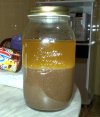I was looking was looking up on local grass fed meat producers for when I'll be living independently (read: on a salary) from next month when I came across some articles mentioning yellow fat, which turns out to indicate that the animal was raised on grass and not grain. Even more importantly:
Not surprisingly in the slightest, it also turns out that abattoirs actually penalize farmers' good and healthy, Omega-rich products.
Of course, according to this nebulous (because no names or origins seem to be mentioned) "team of meat professionals with experience in the industry for more then 35 years now":
Even less surprising, and hardly worth commenting on here, though I thought I should add it for the sake awareness of the "plausible" lie(s) being promulgated throughout the industry.
I looked up beta-carotene though and found this interesting quote from Wikipedia after finding out that it is used to produce Vitamin A (retinal)
In light of this C's comment, though it's likely not the first time this hit has been confirmed
Bottom line: If the fat on your meat is white, that animal was slaughtered on a grain-fed diet.
Moderator note: Yellow fat applies primarily to grass-fed beef
http://www.thekitchenhotline.com/2010/07/why-the-yellow-color-in-beef-fat/..cattle that is fed cereals and corn (either for their entire life or just during the final months) will have pearly white fat.
Not surprisingly in the slightest, it also turns out that abattoirs actually penalize farmers' good and healthy, Omega-rich products.
http://www.farmersweekly.co.za/article.aspx?id=6681&h=The-battle-for-natural-grass-fed-beefThen there is the issue of white “feedlot fat” versus yellow “natural grass-fed fat”, which grass-fed beef producers prefer to call “creamy”. Frikkie Maré from the University of the Free State’s Department of Agricultural Economics explains: “Meat with ‘yellow’ fat – some 157 000t of the 600 000t of South Africa’s annual beef production – is penalised by R1/kg at the abattoir.”
Dr Lorinda Frylinck of the Agricultural Research Council’s meat science research team explains that yellow fat was thought to indicate that an animal was older, and therefore its meat tougher. “But our research shows that the yellow fat found in young animals as a result of diet and environment is not an indication of toughness. Therefore producers should not be penalised.”
Of course, according to this nebulous (because no names or origins seem to be mentioned) "team of meat professionals with experience in the industry for more then 35 years now":
http://www.meat-us.com/quality.php?page=6Although not a meat quality problem, one undesirable effect of allowing animals to graze is yellow fat on the carcass.
Grass contains high levels of beta-carotene, which can be stored in fat giving the fat a yellow color.
Consumers often perceive meat with yellow fat as having come from an old or diseased animal.
An undesirable "grassy" flavor may result from compounds found in forage.
Consumption of wild onions and garlic can also give an undesirable meat flavor.
For these reasons, animals should not be allowed to forage for several weeks before slaughter.
Instead, they should be fed a grain diet.
Even less surprising, and hardly worth commenting on here, though I thought I should add it for the sake awareness of the "plausible" lie(s) being promulgated throughout the industry.
I looked up beta-carotene though and found this interesting quote from Wikipedia after finding out that it is used to produce Vitamin A (retinal)
http://en.wikipedia.org/wiki/Vitamin_AThe carotenes alpha-carotene, beta-carotene, gamma-carotene; and the xanthophyll beta-cryptoxanthin (all of which contain beta-ionone rings), but no other carotenoids, function as vitamin A in herbivores and omnivore animals, which possess the enzyme required to convert these compounds to retinal. In general, carnivores are poor converters of ionine-containing carotenoids, and pure carnivores such as cats and ferrets lack beta-carotene 15,15'-monooxygenase and cannot convert any carotenoids to retinal (resulting in none of the carotenoids being forms of vitamin A for these species).
In light of this C's comment, though it's likely not the first time this hit has been confirmed
http://cassiopaea.org/forum/index.php/topic,23860.0.htmlA: ... Carnivores do not eat other carnivores because it is not optimal energy source.
Bottom line: If the fat on your meat is white, that animal was slaughtered on a grain-fed diet.
Moderator note: Yellow fat applies primarily to grass-fed beef

